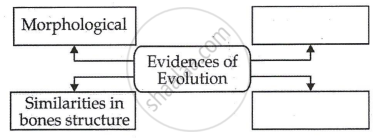Advertisements
Advertisements
Question
Find an odd one out.
Options
Position of eyes
structure of bones of hand
structure of nostrils
structure of ear pinna
Solution
structure of bones of hand
APPEARS IN
RELATED QUESTIONS
State the connecting links between Peripatus with Annelida and Arthopoda.
What are vestigial organs?
Study the following statements:-
I. Wings of birds and wings of bats are homologous organs.
II. Wings of birds and wings of insects are modified forelimbs.
III. Wings of birds and wings of insects are analogous organs.
IV. Wings of birds and forelimbs of horse are homologous organs.
The correct statements are
(A) I and II
(B) II and III
(C) III and IV
(D) I and IV
Differentiate between analogy and homology giving one example each of plant and animal respectively.
Which of the following is a correct set of homologous organs?
(a) Forelimbs of frog, bird and lizard
(b) Spine of cactus and thorn of bougainvillea
(c) Wings of bat and wings of butterfly
(d) Wings of a bird and wings of a bat
Which one of the following pairs of vegetables is an example of homologous structures?
(A) Potato and sweet potato
(B) Carrot and radish
(C) Carrot and tomato
(D) Tomato and radish
Explain with an example for the given, how the following provides evidence in favor of evolution in organisms :
Analogous organs
Name the scientists who Discovered the fossil of Australopithecus
The organs which perform different functions but have the same basic structure are known as :
(a) homologous organs
(b) analogous organs
(c) homolytic organs
(d) analytic organs
The organs which perform similar functions but have different basic structure are called :
(a) asymmetric organs
(b) analogous organs
(c) homologous organs
(d) homophonic organs
The presence of which of the following types of organs in two organisms indicates that they are derived from the same ancestor?
(a) analogous organs
(b) respiratory organs
(c) digestive organs
(d) homologous organs
One pair of organs in the following animals are not homologous. This is :
(a) forelimbs in humans and lizard
(b) forelimbs in lizard and frog
(c) wings in butterfly and bat
(d) wings in bat and bird
The organs P and Q of two animals have different structures but similar functions. On the other hand, the two organs R and S of two other animals have the same basic structure but different functions.
(a) What are the organs like P and Q known as?
(b) Name the organs like P and Q. Also name the animals which have such organs.
(c) What are the organs like R and S called?
(d) Name the organs like R and S. Also name the animals which have such organs.
Select a set of homologous organs from the following:
(A) Wings of a bat and wings of a butterfly
(B) Wings of a pigeon and wings of a bat
(C) Wings of a butterfly and wings of a pigeon
(D) Forelimbs of a duck, forelimbs of a cow and forelimbs of a lizard
What do you mean by vestigial structures? Name four vestigial organs found in man.
Differentiate between connecting links and the missing links.
Find an odd one out.
Name the parts shown in the diagram.
Human jaw

The decaying process of C-14 occurs continuously in dead organisms only.
Give scientific reason.
Peripatus is said to be the connecting link between Annelida and Arthropoda.
Write a short note:
Embryological evidences
Define the evidence of evolution shown in the figure.

Observe the given images and answer the following questions.

- Which evolutionary evidence does it indicate?
- What does it prove?
- State another example of evolutionary evidence.
Biogenetic law states that ______.
The degenerated and non-functional organs found in an organism are called ______.
A human hand, a front leg of a cat, a front flipper of a whale and a bat’s wing look dissimilar and adapted for different functions. What is the name given to these organs?
Select the correct statement.
Select the CORRECT set of homologous organs.
Study of fossils is ______.
The presence of gill slits, in the embryos of all vertebrates, supports the theory of ______.
How do we compute the age of a living tree?
While creation and presence of variation is directionless, natural selection is directional as it is in the context of adaptation. Comment.
What is the function of the appendix of our digestive system?
Write avian characters of Archaeopteryx.
Complete the following conceptual picture:

Give examples of homologous organs and analogous organs in plants.
Pick the odd man out:
